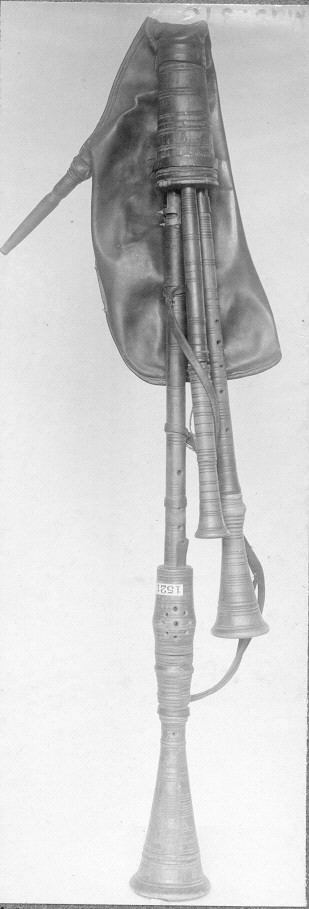Zampogna
19th century
Not on view
The zampogna is a bagpipe found in mountainous regions across Central and Southern Italy, including Sicily. It varies in size, tuning style, and local repertoire but always features two unequal divergent melodic pipes (Baines 1963:95) tuned in either octaves or thirds, and depending on region, anywhere from zero to three drones, most commonly having two drones playing octaves of the dominant (fifth) note of the scale. Melodic pipes are conical and drones consist of two cylindrical parts, the lower of which is wider than the higher section. The melodic pipes and drones are traditionally fitted with double reeds. The surdulina, found in northern Calabria and southern Basilicata, has a slightly different sent up with cylindrical bores and the use of single reeds. Each chanter is played by one hand, with the bass chanter creating a rhythmic/bass accompaniment to the more melodic fingering of the melody chanter. The name ‘zampogna’ most likely derives from the Latin ‘symphonia’ and became a standard name for the bagpipes in Italy from the 15th century onward (Vereno 2022:74).
This is a zampogna a chiave (keyed bagpipe) from Lucania, an ethno-geographic region encompassing parts of modern-day Campania and Basilicata. This bagpipe is of an early design, pre-dating the designs of Carmine Trimarco, a pipe-maker who was active from the end of the 19th century until his death in 1954. Trimarco, followed by his family, defined pipe-making in the Lucania region (Scaldaferri 2020:158). His refined designs were influential and copied by makers across the region. This model predates Trimarco’s work, which establishes it well into the 19th century.
The left bass chanter, which is played by the left hand and is used as an accompaniment to the melody chanter, features a closed bell typical of this regional zampogna-making style. It is elongated, with a longer taper, which is typical of bagpipes from the historical Lucania region. The bells on the right and left chanter are attached to the main body of the melodic pipe with a wooden screw-type fitting where the end of the bore pipe screws into the top of the bell section. The piastrina, the wooden barrel covering the key system on the right melodic chanter, has a slightly uneven pattern, and was manually drilled. The instrument was likely turned on a crude pedal lathe. The bag is unusual in that it is made out of sewn leather, probably cowhide. This type of bag is very uncommon in Italy, where bags generally tend to be made out of a full goat skin. It is possible that the bag was added at a later date after the pipe was transported out of Italy.
The zampogna was traditionally played by shepherds and is still used for a variety of cultural practices, devotional and secular. In the Lucania region and parts of Calabria and the Abbruzzi they are often played in a duo formation with a ciaramella/piffero, a double reeded shawm. This duo has become emblematic of the Christmas season, where traditionally dressed pipers walk from village to village playing the ‘novena’, a form of devotional music (Scaldaferri 2022). Zampogna players have secular and religious repertoires. The former is used for the novena and devotional processions, while the latter are used to accompany dancing and singing.
(Cassandre Balosso-Bardin and David Marker, 2023)
Technical description
2 semi-melodic chanters (bass and melody) of light wood, in 2 sections, with screw-on flaring bells, conical bores: R 687 mm, 5/0 holes; L 1083 mm, 3/0 holes, 1 metal key covered with perforated barrel; reeds missing (typically double cane reeds on metal staples);
2 drones both in two sections, aesthetically flared, but internally cylindrical bells, cylindrical bores – the top section has a narrower cylindrical bore than the lower section, large drone 562 mm;
Hand carved wooden blowpipe 165 mm;
Sewn leather bag;
Cylindrical stock for blowpipe, large conical stock with 4 holes for sounding pipes, metal reinforcing band; pipes and stocks with turned grooving;
Left melodic pipe with metal band at top.
References
Baines, Anthony, 1960. Bagpipes. Oxford: Oxford University Press.
Scaldaferri, Nicola, 2022. ‘The Bagpipes in the Mount Pollino Area (Southern Italy): Morphology and Musical Repertoires.’ In Playing Multipart Music: Solo and Ensemble Traditions in Europe: European Voices IV. Vienna: Böhlau Verlag. pp. 71-93.
Vereno, Michael Peter, 2021. The Voice of the Wind: A Linguistic History of Bagpipes. Lincoln: International Bagpipe Organisation.
Due to rights restrictions, this image cannot be enlarged, viewed at full screen, or downloaded.
This artwork is meant to be viewed from right to left. Scroll left to view more.



